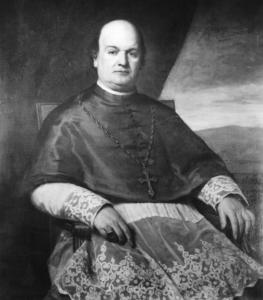The 150th anniversary of Bishop Fitzpatrick's death
Feb. 12, 2016, marked 150 years since the death of Bishop John Bernard Fitzpatrick.
Bishop Fitzpatrick was born on Nov. 15, 1812, to Bernard, a tailor, and his wife Eleanor Flinn. He was involved in the Church from an early age, serving as an altar boy, and in 1825, when Bishop Benedict Joseph Fenwick arrived in Boston, Fitzpatrick revealed to him that he had decided to become a priest.
Bishop Fenwick took an interest in the aspiring priest, personally overseeing his early instruction and, in 1829, arranged for him to study at the Seminary of Saint-Sulpice in Montreal. Bishop Fenwick's efforts were not wasted, as historian Thomas H. O'Connor reveals. Fitzpatrick "kept steadily at his studies and established a reputation as an outstanding student and a model seminarian. In 1833, he was advanced to the rank of instructor in philosophy and theology at the seminary although he was not yet 21 years old."
Eight years later, in 1837, Bishop Fenwick travelled to Montreal to be in attendance for Bishop Fitzpatrick's final examinations, and they returned to Boston together. At the time, the Diocese of Boston was desperate for competent priests, but Fitzpatrick exhibited enormous potential, and was promptly sent to the Seminary of Saint-Sulpice, Paris, for further studies.
Fitzpatrick was ordained on June 13, 1840, and returned to Boston the following fall. While in Boston, he served as pastor of St. Mary's Church in Boston, and then St. John the Evangelist Church in Cambridge. His close relationship with Bishop Fenwick, and the exceptional ability he displayed during his studies, eventually led to his being named coadjutor for the Diocese of Boston in 1842.
On Tuesday, Aug. 11, 1846, after struggling with his deteriorating health for months, Bishop Fenwick passed away. Two days later, Bishop Fitzpatrick celebrated Mass before Fenwick's body was transported to Worcester, his final resting place. At only 33 years of age, Bishop Fitzpatrick returned to Boston to assume his responsibility as the third Bishop of Boston -- the first Bostonian to serve in that role.
Fitzpatrick's tenure as the Bishop of Boston was marked by several significant events, most notably the Irish Potato Famine and the American Civil War. As an immediate response to the famine, Fitzpatrick appealed to the people of Boston for money to be sent to those suffering in Ireland. In doing so, he created the Relief Association for Ireland, dividing the diocese into districts to better organize the fundraising effort.
In addition to sending aid, Bishop Fitzpatrick also had to address the rapid influx of the Irish Catholic immigrants arriving in Boston. This prompted expansion in several areas, including church buildings, cemeteries, hospitals, schools, and orphanages.
There were some negative reactions to the new arrivals, such as the "Know-Nothing" party, and the idea of nativism, both of which reached their peak in the 1850s. Those who supported these movements felt threatened by the newcomers on several fronts, including new competition for jobs, heightened taxes to provide public relief services, and a large community which, if organized, could be very influential in the political arena. In his papers, there is much evidence of Bishop Fitzpatrick's efforts to allay these fears.
Rome also took interest in the large influx of Catholics, and the arrival of Archbishop Gaetano Bedini in the fall of 1853 marked the first time an official from the Holy See in Rome visited the Catholic Church of the United States.
The other major event of the Bishop Fitzpatrick era was the American Civil War (1861-1865). It is acknowledged that Bishop Fitzpatrick supported the Union; however, due to ill health he spent much of the war in Europe trying to recover -- he allegedly did take the opportunity to advocate for the United States with European nations.
Unfortunately, Bishop Fitzpatrick's travels did not prove a cure for his ailments, and he died on February 12, 1866, at only 53 years of age. Statistics from the Catholic Almanac reflect the rapid expansion that took place during his 20 years as bishop. In 1846, it lists 38 churches, 5 churches under construction, 41 priests away on mission, and a Catholic population estimated at 65,000. By 1866, there were 109 churches, 2 chapels, and 6 under construction, and 110 priests away on mission. There are no Catholic population figures provided for 1866, or the following year, but by 1868 it was estimated at over 350,000.
For Further Reading:
"Fitzpatrick's Boston, 1846-1866: John Bernard Fitzpatrick, Third Bishop of Boston," By Thomas H. O'Connor.
"From Generation to Generation: Stories in Catholic History from the Archives of the Archdiocese of Boston," by James M. O'Toole.
John Bernard Fitzpatrick Papers, Archdiocesan Archive.
THOMAS LESTER IS THE ARCHIVIST OF THE ARCHDIOCESE OF BOSTON.



















